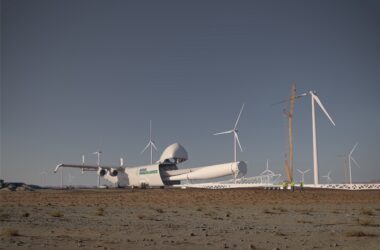In an exciting and forward-thinking venture, Lhyfe, a French clean energy company, and Centrica, a leading British energy and services company, are set to pioneer offshore renewable green hydrogen production in the UK.
The collaboration aims to transform the offshore wind energy industry and contribute significantly to the UK’s zero-carbon emissions target.
Transformative Potential of Offshore Wind Energy
 Harnessing offshore wind energy to produce green hydrogen holds transformative potential for the energy industry. Offshore wind farms, being far from residential areas, negate the challenges of noise and visual pollution often associated with wind energy. In addition, when winds are stronger and more consistent at sea, the efficiency of energy production increases.
Harnessing offshore wind energy to produce green hydrogen holds transformative potential for the energy industry. Offshore wind farms, being far from residential areas, negate the challenges of noise and visual pollution often associated with wind energy. In addition, when winds are stronger and more consistent at sea, the efficiency of energy production increases.
The real breakthrough, however, lies in converting this wind energy into green hydrogen.
What is Green hydrogen?
Green hydrogen production relies on electrolysis, powered by renewable energy sources, which earns the term “green.”
Electrolysis involves splitting water (H2O) into its constituent parts: hydrogen and oxygen.
The process begins with an electrical current being passed through water. This current is drawn from renewable energy sources like wind, solar, or hydroelectric power. In the case of the Lhyfe-Centrica collaboration, offshore wind energy is harnessed and converted into electricity, demonstrating a model use case for wind energy.
This electricity then powers the electrolyser, a device designed to carry out the electrolysis process. Inside the electrolyser, water is divided into its elemental components. The electricity drives a reaction at each electrode in the water, breaking the bonds between the hydrogen and oxygen atoms.
At the positive electrode (anode), oxygen is formed. At the negative electrode (cathode), hydrogen is formed. The two gases are collected separately and can then be stored and transported for use.
The result is green hydrogen, an energy carrier that does not produce carbon emissions when used.
This makes it an eco-friendly alternative to traditional fossil fuels. Its energy storage capabilities also present a solution to the intermittent nature of wind energy, allowing for more effective and efficient use of renewable power sources.
The Lhyfe-Centrica Green Hydrogen Production Initiative
The collaborative initiative between Lhyfe and Centrica is a game-changer, set to make the UK a leading player in the global green hydrogen market. The project is expected to establish a pilot green hydrogen production unit in the North Sea by 2025, aiming to harness offshore wind energy and produce green hydrogen on an industrial scale.
The partnership will take a two-step approach. First, offshore wind turbines will generate electricity. This electricity, free from any carbon emissions, will power an electrolyser to split water into hydrogen and oxygen. The hydrogen will then be stored and transported across various sectors, from powering homes to fueling hydrogen-powered vehicles.
The pilot project, while significant on its own, is just the beginning. Once established, it could scale up, contributing to the UK government’s aim to produce 5GW of low-carbon hydrogen by 2030 as part of its Hydrogen Strategy.
Implications for the UK’s Renewable Energy Sector
The Lhyfe-Centrica partnership and the resulting offshore green hydrogen production could have far-reaching implications for the UK’s renewable energy sector. By marrying wind energy with green hydrogen production, the initiative paves the way for cleaner, renewable energy sources and addresses critical challenges in the energy sector.
The green hydrogen produced would provide a sustainable and flexible energy source, helping to reduce the UK’s dependence on fossil fuels and lower carbon emissions. It could also support the grid by providing a practical storage solution for excess wind power, reducing the problems associated with intermittency.
Moreover, the project would create numerous jobs, aiding the local economy. It also has the potential to position the UK as a leader in the green hydrogen industry, attracting significant investments and fostering innovation in renewable energy technologies.
The collaboration between Lhyfe and Centrica signals a promising step toward a cleaner, greener future. Transforming wind energy into green hydrogen is more than just producing renewable energy. It’s about innovating and pioneering sustainable solutions that can meet our growing energy demands without compromising the health of our planet.
Innovation Driving Sustainable Development
This innovative move towards green hydrogen production is more than just a new venture for Lhyfe and Centrica. It exemplifies the positive direction energy companies must take, a testament to the innovation necessary for combating climate change. This development underscores the capability of private enterprises to contribute significantly to global sustainable development goals.
Green hydrogen stands at the forefront of the energy transition. As a versatile energy carrier with multiple applications, it holds the potential to decarbonise various sectors. From heating homes to powering vehicles and industries, green hydrogen offers a way to store and use energy without harming our environment.
The Lhyfe-Centrica venture could act as a case study for the feasibility of this sustainable fuel source. In harnessing offshore wind power to produce green hydrogen, the project reinforces the importance and viability of this revolutionary energy solution in our move towards a greener future.
As the project unfolds, it will undoubtedly face hurdles. However, the commitment of these companies to sustainable energy, coupled with their expertise and innovative approach, is set to navigate these challenges successfully. The venture holds promise as a beacon of inspiration for other energy companies and nations, encouraging them to invest in renewable energy solutions and take significant strides towards a sustainable future.
In conclusion, the Lhyfe and Centrica collaboration is more than a landmark development in the UK’s energy industry. It is a bold statement that renewable energy innovation and collaboration are the keys to addressing our global climate crisis.
This venture signals a brighter, greener, and more sustainable future.
TLDR
- French company Lhyfe and British company Centrica are collaborating to pioneer offshore renewable green hydrogen production in the UK.
- Offshore wind energy has transformative potential for the energy industry, as it overcomes challenges like noise and visual pollution.
- Green hydrogen is produced through electrolysis, powered by renewable energy sources like offshore wind.
- The collaboration aims to establish a pilot green hydrogen production unit in the North Sea by 2025.
- Offshore wind turbines will generate electricity, which will power an electrolyser to split water into hydrogen and oxygen.
- Green hydrogen can be stored and transported for various uses, providing an eco-friendly alternative to fossil fuels.
- The initiative contributes to the UK government’s goal of producing 5GW of low-carbon hydrogen by 2030.
- Offshore green hydrogen production could reduce the UK’s dependence on fossil fuels, lower carbon emissions, and provide a storage solution for excess wind power.
- The project will create jobs, boost the local economy, and position the UK as a leader in the green hydrogen industry.
- This initiative exemplifies the innovation required for sustainable development and highlights the importance of private enterprises in addressing climate change.
- Green hydrogen offers versatile applications and can decarbonize various sectors, contributing to a greener future.
- The Lhyfe-Centrica collaboration encourages other energy companies and nations to invest in renewable energy solutions.
- The project faces challenges, but the companies’ commitment to sustainable energy and innovative approach will help overcome them.
- This collaboration signifies a significant step towards a brighter, greener, and more sustainable future.







